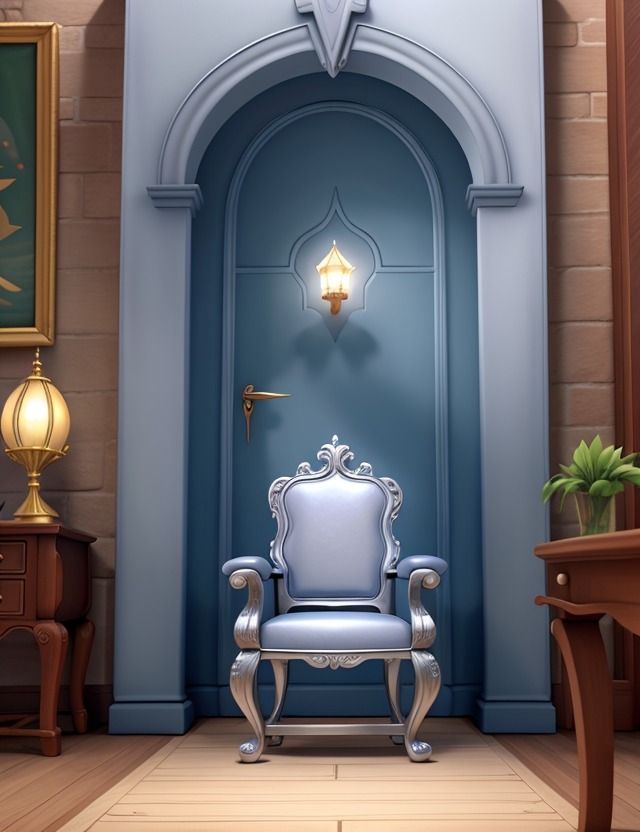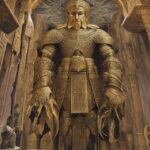Step into a world where darkness lurks, treacherous villains scheme, and unlikely heroes embrace their destinies. In C.S. Lewis’ timeless masterpiece, “The Silver Chair,” the adventurous journey of Eustace Scrubb and his new companion, Jill Pole, takes readers on a thrilling quest to rescue a missing prince. Set in the fantastical realm of Narnia, this enchanting tale captures the essence of bravery, loyalty, and the enduring power of friendship. In this article, we will delve into the captivating narrative, uncovering its rich symbolism, exploring the profound themes it illuminates, and unveiling the enduring impact it has had on millions of readers worldwide.
Prepare to be whisked away into a world where courage and wit are tested, and where the shadows of doubt are overcome with the gleam of hope. Let us embark on this remarkable journey, as we unravel the secrets hidden within “The Silver Chair.”
The Silver Chair: Full Book Summary
Once upon a time, in the magical land of Narnia, there lived two young children named Jill and Eustace. They were very brave adventurers who had already been to Narnia once before, and they couldn’t wait to go back again. This time, their incredible journey begins when they are magically transported by Aslan, the great lion and ruler of Narnia, to a new and exciting adventure in the book “The Silver Chair”.
Jill and Eustace find themselves in a strange and mysterious land, where they soon encounter a beautiful and enchanting young lady named Lady Polly. Lady Polly tells them that she has been trapped in this world for many years and is desperately seeking a way to escape. She informs the children that they must embark on a quest to find the lost Prince Rilian, who has mysteriously vanished. It is believed that the evil Green Witch, who rules this land called Underland, is behind the prince’s disappearance.
Guided by a series of clues and assisted by a blessed creature called a Marsh-wiggle named Puddleglum, Jill and Eustace embark on a perilous journey across the treacherous terrain of Underland. Their quest takes them through dark and twisted forests, over dangerous mountains, and into the sinister depths of the Underland kingdom. Along the way, they encounter strange creatures, bewitching enchantments, and face many challenging obstacles.
One of the most exciting and terrifying encounters for the children is when they come face to face with the monstrous serpent-like creature known as the Serpent of the Silver Chair. This creature has the ability to enchant and mesmerize anyone who looks into its eyes. Jill, Eustace, and Puddleglum must summon all their courage and wits to resist its temptation.
As their journey progresses, Jill, Eustace, and Puddleglum uncover the true intentions of the Green Witch. She plans to use Prince Rilian as her puppet, spreading darkness and evil throughout Narnia. The children are determined to rescue Prince Rilian and bring him back to his rightful place as the ruler of Narnia.
In their final showdown with the Green Witch, Jill, Eustace, and Puddleglum must overcome numerous obstacles and dangers. The Green Witch uses her dark powers to try and enchant them into forgetting their mission and joining her side. But through the power of Aslan and their unwavering belief in goodness, the children and Puddleglum manage to resist her spells and free Prince Rilian from her clutches.
With Prince Rilian rescued, the children and Puddleglum journey back to Narnia. There, they are joyfully reunited with Aslan, who commends their bravery and determination. Aslan tells Jill and Eustace that their adventure in Underland has taught them important lessons about courage, loyalty, and the power of their own beliefs. He explains that sometimes, even when all seems lost, it is essential to hold onto hope and to trust in the goodness that lies within.
Jill, Eustace, and Puddleglum return home, forever changed by their incredible journey. They have learned the value of friendship and the importance of standing up to evil, even in the most treacherous of circumstances. The children know that they will always hold a special place in their hearts for the enchanted land of Narnia, and that their memories of their time spent with Aslan and their fellow adventurers will stay with them forever.
“The Silver Chair” is a thrilling and fantastical tale that enchantingly weaves together themes of bravery, loyalty, and the power of belief. It captures the imagination of young readers, transporting them to a world where anything is possible and where the forces of good always triumph over evil. With its unforgettable characters and gripping storyline, this book is sure to inspire and captivate the minds and hearts of all who embark on this incredible adventure. So, gather your courage, embrace your imagination, and get ready to join Jill, Eustace, and their beloved friend Puddleglum as they embark on an unforgettable quest to save Narnia once again.
The Silver Chair: Key Themes
The Silver Chair is the sixth book in C.S. Lewis’s beloved fantasy series, The Chronicles of Narnia. It follows the adventures of two children, Eustace Scrubb and his schoolmate Jill Pole, as they journey to the land of Narnia. Here are three key themes explored in the book:
1. The Power of Friendship: Throughout the story, the power of friendship is emphasized. Eustace and Jill initially don’t get along, but they learn to trust and rely on each other as they navigate the challenges they face in Narnia. Their friendship grows stronger as they support and encourage each other, demonstrating the importance of loyalty and companionship in overcoming adversity.
2. The Peril of Darkness and Deception: The Silver Chair portrays the dangers of darkness and deception. The land of Narnia is under the influence of an evil enchantress, the Lady of the Green Kirtle, who uses her deceptive powers to manipulate and control others. Eustace and Jill must tread carefully, discerning truth from lies, and resisting the temptation to succumb to the enchantress’s illusions. This theme highlights the power of truth, integrity, and the need to remain vigilant against deceitful influences.
3. The Quest for Identity: Throughout the story, the characters struggle with their own identities and self-discovery. Eustace, who previously appeared in The Voyage of the Dawn Treader, continues his personal growth as he confronts his past flaws and insecurities. Jill, on the other hand, starts the story feeling inadequate and unsure of herself. As they navigate their mission in Narnia, they both learn valuable lessons about bravery, self-belief, and the importance of embracing one’s true identity. This theme serves as a reminder that personal growth and self-acceptance are integral parts of any heroic journey.
Overall, The Silver Chair is a captivating fantasy novel that explores the themes of friendship, the perils of darkness and deception, and the quest for identity. Through the fantastical world of Narnia, C.S. Lewis offers readers valuable insights about the power of loyalty, truth, and self-discovery.
The Silver Chair: Characters
1. Eustace Scrubb: A young boy with glasses and a bratty attitude, Eustace is sent to a boarding school where he discovers a magical world. Though initially selfish, he learns valuable lessons about courage and friendship throughout the story. Funny data: Eustace has a fear of heights and enjoys collecting dragon figurines.
2. Jill Pole: Jill is a resourceful and determined young girl with long, dark hair. She becomes Eustace’s companion in the magical world and together they embark on a dangerous quest to rescue a missing prince. Funny data: Jill has a talent for climbing trees and has a knack for guessing the right answers in difficult situations.
3. Puddleglum: A delightfully gloomy Marsh-wiggle, Puddleglum is a tall and thin creature with green, spongy skin. Despite his dour demeanor, he is loyal and selfless, often providing comical, yet insightful, commentary. Funny data: Puddleglum has an uncanny ability to predict gloomy outcomes, but he always manages to find a way to persevere.
4. Prince Rilian: The missing prince they seek to rescue, Rilian appears regal and handsome, with a silver crown atop his golden hair. However, he is under an enchantment that causes him to forget his true identity and believe in a false Queen. Funny data: Rilian’s favorite pastime is playing the flute and his laughter sounds like the tinkling of silver bells.
5. The Lady of the Green Kirtle (Queen Jadis): A mysterious and captivating antagonist, the Lady of the Green Kirtle is a beautiful witch who uses her enchantments to manipulate and deceive those around her. She has golden hair, bewitching green eyes, and an alluring yet dangerous charm. Funny data: The Lady has an unusual fondness for collecting gemstones and enjoys planting poisonous herbs in her spare time.
6. Glimfeather: A wise and elderly owl, Glimfeather is a loyal friend to the children on their journey. He has soft, feathery gray plumage with bright yellow eyes that seem to hold a twinkle of wisdom. Funny data: Glimfeather is known for his endless repertoire of owl puns and often hoots with laughter at his own jokes.
7. Giant Warden: A fearsome and imposing creature, the Giant Warden safeguards a bridge leading to the land of the evil Queen. He stands over ten feet tall, with bulging muscles and a deep voice that rumbles like thunder. Funny data: Despite his intimidating appearance, the Giant Warden has an inexplicable fear of spiders and shrieks like a startled schoolgirl at the sight of them.
8. Aslan: The great and majestic lion, Aslan is the ultimate symbol of goodness and guidance throughout the Chronicles of Narnia. He possesses a regal aura, with a golden mane and eyes that radiate wisdom and compassion. Funny data: Aslan has an impeccable singing voice and can often be found humming catchy tunes to himself as he goes about his business in Narnia.
The Silver Chair: Symbols
1. The Silver Chair: The silver chair itself is a powerful symbol in the book. It represents the temptation and enticement of power, as well as the danger of becoming trapped by one’s desires. When Jill and Eustace find the chair, they are initially drawn to its beauty and elegance, but soon realize that sitting in it causes them to forget their true purpose and duty. The silver chair symbolizes the allure of worldly desires and the need for self-control and perspective in order to stay true to one’s mission.
2. The Signs: Throughout their journey, the protagonists encounter an ambiguous and enigmatic set of signs that guide them. These signs are described as instructions written in a language they can’t understand, but they are meant to steer them in the right direction. The signs symbolize faith, trust, and the need to rely on something larger and wiser than oneself. They also reflect the idea that sometimes in life, we must have faith in the unknown and take steps even when we don’t fully understand the path ahead.
3. The Enchanted Water: In the latter part of the book, the protagonists stumble upon an underground kingdom ruled by a witch called the Lady of the Green Kirtle. She uses an enchanted water from an underworld stream to control and manipulate the minds of those who drink it. The enchanted water symbolizes the power of deception and manipulation. It represents the dangers of succumbing to false ideologies or beliefs that can cloud one’s judgment and lead them astray from the truth. The water reminds us to be vigilant and discerning, as well as to question the motives and intentions of those who seek to influence us.
The Silver Chair: Culture Impact
“The Silver Chair,” the fourth installment in C.S. Lewis’ beloved Chronicles of Narnia series, published in 1953, had an immense cultural impact that continues to resonate with readers across generations. Through its enchanting narrative, fantastic characters, and thought-provoking themes, this book has left an indelible mark on popular culture.
First and foremost, “The Silver Chair” further solidified the Chronicles of Narnia as a timeless cornerstone of children’s literature. Its publication only heightened the popularity and longevity of the series, which has since captivated millions of young readers worldwide. Lewis’ magical storytelling and his ability to effortlessly transport readers to the enchanting realm of Narnia served as a catalyst for inspiring a love of reading and imagination in generations to come.
Historically, “The Silver Chair” subtly reflects the cultural climate of its time during the 1950s. This era was marked by an intense post-war period, and this book served as a source of escapism, offering solace to readers seeking respite from the realities of the world. Its fantastical elements, such as giant talking owls, underground realms, and perilous quests, provided readers with an opportunity to momentarily suspend their worries and delve into a world where good ultimately triumphs over evil.
Additionally, “The Silver Chair” further expanded upon the core themes presented in the Chronicles of Narnia series. It explored the ideas of sacrifice, courage, and the power of belief, resonating deeply with readers of all ages. Lewis’ ability to seamlessly weave philosophical concepts into an engaging narrative allowed young readers to contemplate profound ideas while simultaneously being entertained. This aspect contributed to shaping the moral compass of many individuals and fostered a sense of empathy and understanding.
One of the most remarkable achievements of “The Silver Chair” lies in its introduction of memorable characters. The fair and just Aslan, the courageous protagonists Eustace Scrubb and Jill Pole, and the captivating Puddleglum the Marsh-wiggle all became emblematic figures of the Narnia universe. Readers developed deep connections with these characters, often mimicking their courageous acts, witty dialogue, and unwavering commitment to good. In turn, this fostered a sense of camaraderie among fans and led to a vibrant fan culture that continues to thrive today, with cosplayers, fan fiction writers, and dedicated communities celebrating the wonders of Narnia.
Funny and enchanting, “The Silver Chair” seamlessly merges its core themes with moments of levity and whimsy. Lewis’ incorporation of lighter moments throughout the narrative, such as humorous banter between characters or unexpected twists, ensures that readers are thoroughly engaged and entertained. The balance between the serious and the light-hearted contributes to the book’s enduring popularity as readers are continuously drawn to its enchanting blend of adventure, laughter, and contemplation.
In conclusion, “The Silver Chair” holds a significant cultural impact, having enthralled readers for decades. Through its historical context, profound themes, memorable characters, and seamless storytelling, this book has left an indelible mark on popular culture, shaping both the literary landscape and the hearts of individuals young and old.
FAQs
1. Is “The Silver Chair” the fifth book in the Chronicles of Narnia series?
Yes, “The Silver Chair” is indeed the fourth book in the Chronicles of Narnia series. It follows the story of Eustace Scrubb and his classmate Jill Pole as they journey to Narnia.
2. Can “The Silver Chair” be read as a standalone novel?
While “The Silver Chair” can be enjoyed as a standalone novel, it is recommended to read the previous books in the Chronicles of Narnia series to fully understand the world, characters, and overarching storylines.
3. What age group is “The Silver Chair” suitable for?
“The Silver Chair” is generally recommended for children and young adults aged 9 and above. However, the book’s compelling storytelling and themes make it enjoyable for readers of all ages.
4. Are there any religious elements or allegories in “The Silver Chair”?
Similar to the other books in the Chronicles of Narnia series, “The Silver Chair” does contain religious elements and allegorical references, due to C.S. Lewis’s Christian beliefs. These elements often explore themes of faith, redemption, and sacrifice.
5. Can I watch a film or TV adaptation of “The Silver Chair”?
As of now, there hasn’t been a film or TV adaptation specifically for “The Silver Chair.” However, in 2018, Netflix announced that they would be producing new adaptations of all seven books in the Chronicles of Narnia series, including “The Silver Chair.”
6. Who are the main characters in The Silver Chair and what are their roles in the story?
The main characters are Eustace Scrubb and Jill Pole, two children from England who are sent to Narnia by Aslan to find and rescue Prince Rilian, the son of King Caspian X, who has been kidnapped by an evil witch. They are accompanied by Puddleglum, a pessimistic but loyal Marsh-wiggle, who serves as their guide and protector. They also meet various other characters, such as the Lady of the Green Kirtle, the witch who has enchanted Rilian and plans to conquer Narnia; the Black Knight, who is actually Rilian under the witch’s spell; the Earthmen, the underground dwellers who serve the witch; and the giants of Harfang, who intend to eat the travelers.
7. What are the signs that Aslan gives to Eustace and Jill to guide them on their quest?
Aslan gives four signs to Eustace and Jill before he sends them to Narnia. They are:
- As soon as you land in Narnia, you will meet an old and dear friend. Greet him at once and do what he tells you.
- You will know the lost prince, if you find him, by this: that he will be the first person you have met in Narnia who will ask you to do something in my name, in the name of Aslan.
- At a place where you see a sign that says “Under Me”, you must journey to the utter east and descend into the darkness.
- You will not have achieved your goal until you hear a word spoken by a green bird in a green valley.
8. How do Eustace and Jill free Rilian from the witch’s enchantment and what happens to the witch?
Eustace and Jill free Rilian from the witch’s enchantment by destroying the silver chair that binds him every night and renews the spell. They do this after they hear Rilian beg them to free him in the name of Aslan, which is the second sign. The witch then tries to deceive them by creating a green mist that makes them forget Narnia and Aslan, and by pretending to be a benevolent queen who wants to help them. However, Puddleglum resists the witch’s magic and reminds them of the truth, and then stamps out the fire that produces the mist. The witch then reveals her true form, a green serpent, and attacks them. Rilian kills the witch by cutting off her head with his sword.
9. What are the main themes and messages of the book?
The book explores several themes and messages, such as the power of faith, the nature of good and evil, the importance of obedience, the value of friendship, and the meaning of courage. One of the main themes is the contrast between the surface and the underground, and the conflict between the Narnians and the Earthmen. The book shows the dangers and temptations of the underground world, where the witch and her minions dwell, and where the travelers lose their sense of reality and identity. The book also shows the beauty and joy of the surface world, where Aslan and his creatures live, and where the travelers regain their hope and purpose. The book also shows the role of Eustace and Jill in helping Rilian reclaim his throne and restore peace and harmony to Narnia.










